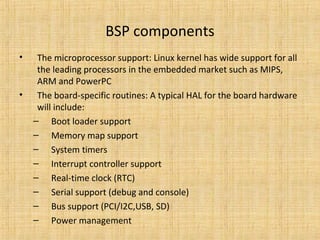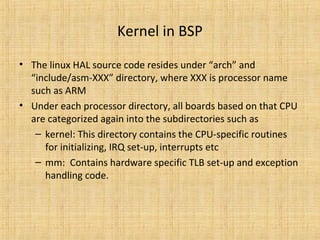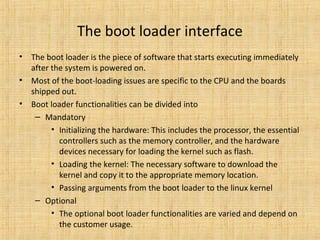Board support package_on_linux
- 1. Board support package on Linux •Board support package or BSP is the set of software used to initialize the hardware devices on the board and implement the board specific routines that can be used by the kernel and device drivers alike. •BSP is thus a hardware abstraction layer (HAL) gluing the to the OS by hiding the details of the processor/CPU and the board.
- 2. BSP components • The microprocessor support: Linux kernel has wide support for all the leading processors in the embedded market such as MIPS, ARM and PowerPC • The board-specific routines: A typical HAL for the board hardware will include: – Boot loader support – Memory map support – System timers – Interrupt controller support – Real-time clock (RTC) – Serial support (debug and console) – Bus support (PCI/I2C,USB, SD) – Power management
- 3. Kernel in BSP • The linux HAL source code resides under “arch” and “include/asm-XXX” directory, where XXX is processor name such as ARM • Under each processor directory, all boards based on that CPU are categorized again into the subdirectories such as – kernel: This directory contains the CPU-specific routines for initializing, IRQ set-up, interrupts etc – mm: Contains hardware specific TLB set-up and exception handling code.
- 4. The boot loader interface • The boot loader is the piece of software that starts executing immediately after the system is powered on. • Most of the boot-loading issues are specific to the CPU and the boards shipped out. • Boot loader functionalities can be divided into – Mandatory • Initializing the hardware: This includes the processor, the essential controllers such as the memory controller, and the hardware devices necessary for loading the kernel such as flash. • Loading the kernel: The necessary software to download the kernel and copy it to the appropriate memory location. • Passing arguments from the boot loader to the linux kernel – Optional • The optional boot loader functionalities are varied and depend on the customer usage.
- 5. Memory map • The memory map defines the layout of the CPU’s addressable space. • The memory map is needed for the following reasons: – It freezes on the address space allocated for various hardware components such as RAM, flash, and memory-mapped IO peripherals. – It highlights the allocation of onboard memory to various software components such as the boot loader and the kernel. This is crucial for building the software components; this information is fed normally via a linker script at the time of building. – It defines the virtual-to-physical address mapping for the board. This mapping is highly processor and board-specific; the design of the various onboard memory and bus controllers on the board decides this mapping.
- 6. Memory addresses seen on embedded linux systems • There are three addresses that are seen on an embedded Linux system: – CPU un-translated or the physical address: This is the address that is seen on the actual memory bus. – CPU translated address or the virtual address: This is the address range that is recognized by the CPU as the valid address range. The main kernel memory allocator kmalloc(), for example, returns a virtual address. The virtual address goes through an MMU to get translated to a physical address. – Bus address: This is the address of memory as seen by devices other than the CPU. Depending on the bus, this address may vary. • A memory map binds the memory layout of the system as seen by the CPU, the memory devices (RAM, flash, etc.), and the external devices; • This map indicates how the devices having different views of the addressable space should communicate. In most of the platforms the bus address matches the physical address, but it is not mandatory. • The Linux kernel provides macros to make sure that the device drivers are portable across all the platforms.
- 7. Memory map creation • The creation of the memory map for the system can be broken down into the following tasks. • The processor memory map: This is the first memory map that needs to be created. It explains the CPU’s memory management policies such as how the CPU handles the different address spaces (user mode, kernel mode), what are the caching policies for the various memory regions, and so on. • The board memory map: Once there is an idea of how the processor sees the various memory areas, the next step is to fit the various onboard devices into the processor memory areas. This requires an understanding of the various onboard devices and the bus controllers. • The software memory map: Next a portion of the memory needs to be given for the various software components such as the boot loader and the Linux kernel. The Linux kernel sets up its own memory map and decides where the various kernel sections such as code and heap will reside.
- 8. Board memory map • Board memory map gives the mapping for various device memory space • The following is the memory map designed for the Psuedo board that has 8 MB of onboard SDRAM, 4 MB of flash, and IO devices that require 2 MB of memory map range. • 0x80000000 to 0x80800000: Used to map the 8 MB of SDRAM • 0xBFC00000 to 0xC0000000: Used to map the 4 MB of flash • 0xBF400000 to 0xBF600000: Used to map the 2 MB of IO peripherals
- 9. Software memory map • The 8 MB of SDRAM is made available for running both the boot loader and Linux kernel. • The Linux memory map setup is divided into following stages. – The Linux kernel layout — the linker script, how the various sections are laid out – The boot memory allocator • The boot memory allocators are the kernel dynamic allocators during the early stages of the kernel (before paging is set up); once paging is set up the zone allocators are responsible for dynamic memory allocation. – Creation of various memory allocator zones by the kernel • DMA Zone: This zone contains pages that undergo DMA • Normal Zone: This zone contains normal, regularly mapped , pages. • Highmem Zone: Many processors cannot access all of the physical memory because of the small size of the linear address space. This zone is used to map such memory into kernel address space.
- 10. Interrupt management • Every board is unique with its hardware interrupt management, mostly because of the PIC (Programmable Interrupt Controller) interface. • The Linux kernel treats all interrupts as logical interrupts; logical interrupts are directly connected to the processor or may go via a PIC. • In both the cases when an interrupt is registered (via the request_irq() function), the device driver needs to pass an interrupt number as an argument that identifies the interrupt number; the interrupt number passed is that of the logical interrupt number
- 11. Timers • There are two timers that need to be programmed by the BSP: • The Programmable Interval Timer (PIT): This timer is hooked to the timer interrupt that provides the system pulse or ticks. For e.g. The default value for a tick on an X86 Linux system is 1 msec. This is mandatory • The Real-Time Clock (RTC): This is independent of the processor as it is an external chip on the board. The RTC is operated by a special battery that powers it, even when the board is switched off; thus once programmed it can provide the time of day services. This is not mandatory.
- 12. Power management • Many types of embedded devices have different power requirements depending on their usage. • Devices such as cell phones need to consume less energy so that battery life is not cut short. • Linux provides power management framework and provide different policies to enforce power management. • New embedded processors take these into account and offer two schemes: – dynamic frequency scaling and – dynamic voltage scaling. • The modes offered by the CPUs are controlled typically by the OS, which can deduce the mode depending on the system load. The OS running on these systems can tune the processor’s power consumption depending on the system load.
- 13. • In case the processor is idling waiting for user events, it would be attending to minimal tasks necessary for the system such as servicing timer interrupts. If a processor supports idle mode, then the OS can put the CPU into the idle mode under such conditions. • The idle mode is the mode where the various processor clocks are stopped (the clocks to the peripherals may be still active). • Some processors go still further and offer another mode called the sleep mode wherein the power to the CPU and most of the peripherals is turned off.













